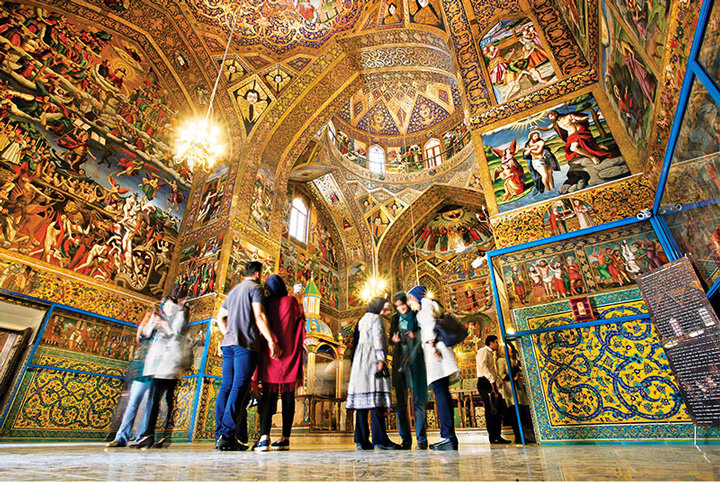Over the past millennia, Iran has witnessed many events, both social and technological, religious, cultural, etc. which have resulted in current differences of races, languages, religions, and cultural differences.
During the Parthian period, Christianity and the call to Christianity arose in Iran, and some converted. Gradually, shrines to the followers of this religion sprang up all over Iran, each built in a different way.
Although Christianity does not currently make up a large portion of Iran's population, this religion, along with Zoroastrians and Judaism, constitutes Iran's non-Islamic religions and has more than a million adherents. Currently, Iran is home to more than 600 churches and over 300,000 Christian practitioners.
Churches, chapels, and cathedrals, as symbols of the Christian world, are usually beautifully adorned to display unmatched architectural features. Today, there are nearly 600 churches in Iran, 90 of which are listed on the National Monuments list and three are recognized as World Heritage.
Here are glimpses of eight significant churches in the country:
Saint Sarkis Cathedral
Located in downtown Tehran, Saint Sarkis Cathedral was Constructed in the early 1970s as an Armenian Apostolic Church.
A highlight of this church is the Armenian Genocide Memorial in the courtyard of the building, commemorating the Armenians exterminated by the Ottomans in the second decade of the 20th century. The outer part of St. Sarkis Cathedral is made of white marble, and the inner walls are covered with paintings on biblical themes.
Cathedral of Saint Savior
The Cathedral of Saint Savior, also known as Vank Church, is a beautiful cathedral located in the historic area of Jolla in central Isfahan.
Built between 1648 and 1655 with the encouragement of the Safavid rulers, the cathedral has a sumptuous interior richly decorated with restored wall paintings full of life and color, including gruesome martyrdoms and pantomime demons.
Befitting a city of miniaturists, relatively recent gifts to the museum include a prayer written on a single hair, visible only with the aid of a microscope and one of the smallest prayer books in the world.
Saint Mary Church of Tabriz
The Saint Mary Church of Tabriz, also known as Holy Mother of God Church, was built during the 12th century based on the Armenian style of architecture in the center of Tabriz where the historical area of Dik Bashi is now located.
The church has been mentioned by historians such as Marco Polo during his excursion to China around the year 1275. It is interesting to know that the church has been rebuilt on the ruins of a church that was beforehand destroyed by a devastating earthquake in 1780.
Saint Garapet Church
Saint Garapet Church was constructed in the mid-20th century in the oil-rich city of Abadan, southwest Iran.
It was one of the largest places of gathering for the Armenian community in Abadan at the time, however, due to the low population of Armenians in the city, it is no longer operational. It was damaged in the 1980-1980 Iran–Iraq war but was later restored.
Armenian Monastic Ensembles of Iran
The Armenian Monastic Ensembles of Iran in the northwest of the country consists of three monastic ensembles of the Armenian-Christian faith: St. Thaddeus, St. Stepanos and the chapel of Dzordzor.
These buildings — the oldest of which, St. Thaddeus, dates from the 7th century — are examples of the outstanding universal value of Armenian architectural and decorative traditions. They testify to a very important exchange with the other regional cultures, in particular the Byzantine, Orthodox, and Persian.
Located on the southeastern edge of the main zone of the Armenian cultural space, the monasteries formed an important center for the spread of this culture in the region. They are the last regional remnants of that culture still in a satisfactory state of integrity and authenticity. In addition, the monastic ensembles, as places of pilgrimage, are living witnesses of Armenian religious traditions over the centuries.
In July 2005, Shahriar Adl, who headed the team documenting three Iranian churches for inscription on the UNESCO World Heritage List, said they had discovered a box containing the bones of one of the followers of Jesus' apostles in St. Stephen's Church.
The Armenian Orthodox primate of the diocese of Tehran, Archbishop Sebuh Sarkisian, approved the report in his August 2005 interview, adding, “About the box, which contains the remains of the apostles’ bodies and was found under the altar of the St. Stephanus Church, it is said that the box contains the body of John the Baptist. According to Armenian historian Arakel Davrizhetsi (17th century), the box, which was located under the main altar of the Church of the Holy Trinity in old Jolfa and contained the sacred remains and a scroll, was given to Shamun, the archbishop of St. Stephanus Church, after the Church of the Holy Trinity was destroyed.”
“The remains may very likely have historic value. According to the tradition of the church, we know that after St. Gregory the Illuminator was consecrated as archbishop of Caesarea in Cappadocia, in a friendly gesture, he gave some remains of John the Baptist to Quintius, the archbishop of the region, during his return trip to Armenia. The remains were transferred to the John the Baptist Cathedral in the city of Mush in Armenia.
TAGS


No comments:
Post a Comment